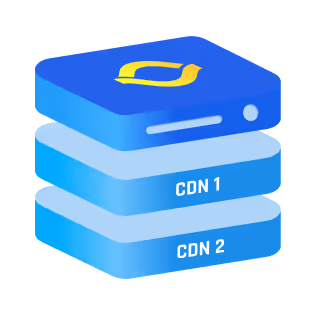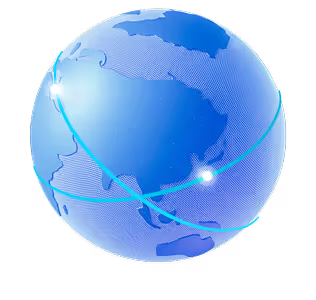The internet is a labyrinth of innovation, where data travels across the globe in milliseconds, connecting users to a world of information and services. It's a dynamic network, continuously evolving to meet the increasing demands for speed, reliability, and security in digital communication.
In this digital world, a very sophisticated, yet simple technology does all the heavy lifting. Known as the Global Cloud Delivery Network, this technology works tirelessly in the background to make your online interactions smooth and quick - be it accessing a website from another continent, or downloading a file.
What is a Global CDN?
A Global Content Delivery Network (Global CDN) is a network of servers strategically distributed across various geographic locations around the world. The primary function of a Global CDN is to improve the speed and efficiency of content delivery over the internet.
This network serves as a bridge between the origin server of a website (where the data is originally hosted) and the user, ensuring that the data travels the shortest possible distance to reach its destination.
{{cool-component}}
How do Global CDNs Work?
Global Content Delivery Networks (CDNs) operate on a complex yet efficient principle, designed to optimize the delivery of internet content around the world. Their working mechanism involves several key components and processes:
Distribution of Data Centers
- Network of Servers: Global CDNs consist of a vast network of servers spread across different geographical locations. These servers, also known as edge servers, are strategically placed in various regions to cover a broad area globally.
- Data Centers: These edge servers are housed in data centers, which are equipped with the necessary infrastructure to store, process, and deliver content efficiently.
Content Replication and Caching
- Caching of Content: When a website utilizes a CDN, copies of its static content (like images, videos, CSS files) are stored (cached) on these edge servers. Dynamic content, which changes frequently, can also be handled through advanced CDN configurations.
- Content Synchronization: The CDN ensures that the cached content on all edge servers is up-to-date.
Request Routing and Content Delivery
- User Request: When a user accesses a website, the request is not sent directly to the origin server. Instead, it is routed to the nearest CDN edge server.
- Intelligent Routing: The CDN uses intelligent algorithms to determine the closest and most efficient server to handle the request, considering factors like server load, distance, and network conditions.
- Content Delivery: The edge server then delivers the requested content to the user. If the content is not available on the edge server, it fetches it from the origin server or another closer edge server, caches it for future requests, and then delivers it to the user.
Load Balancing and Traffic Management
- Load Balancing: Global CDNs distribute user requests and traffic across multiple servers, ensuring no single server is overwhelmed, which improves website performance and reliability.
- Traffic Optimization: CDNs use various techniques like data compression and persistent connections to optimize data transfer, reducing latency and improving load times.
Security and Protection
- DDoS Mitigation: Global CDNs can absorb and disperse large volumes of traffic, which is crucial in protecting against Distributed Denial of Service (DDoS) attacks.
- Security Layers: They also provide additional security features like Web Application Firewalls (WAF), SSL/TLS encryption, and secure token authentication to enhance data integrity and privacy.
Continuous Monitoring and Analytics
- Real-Time Monitoring: CDNs continuously monitor traffic and server performance, allowing for real-time adjustments to handle spikes in traffic or potential threats.
- Analytics and Reporting: They provide valuable insights into user behavior, traffic patterns, and performance metrics, aiding in further optimization of content delivery.
Global CDN vs. Regional CDN
A regional CDN optimizes delivery within one continent or economic area; a global CDN spans every populated region, routing traffic across oceans as seamlessly as across town.
Main differences are summarized below.
Use Cases and Industries Leveraging Global CDNs
Global Content Delivery Networks (CDNs) have become vital across various industries, each leveraging their capabilities to enhance performance, user experience, and efficiency.
Here are some prominent use cases and industries benefiting from CDNs:
Cross-Border Data Compliance (GDPR, China’s CSL)
Operating a Global CDN means serving bytes under vastly different privacy laws:
Conclusion
In essence, the future of the internet, with its ever-growing demand for faster, more secure, and efficient content delivery, will undoubtedly continue to be sculpted by the advancements in Global CDN technology. As we look forward, it's clear that Global CDNs will not only support but drive the evolution of digital communication, ensuring that the world remains more connected than ever.
FAQs
1. How do Global CDNs ensure fast content delivery?
They replicate files to hundreds of edge PoPs and route users via Anycast to the nearest node. Smart caching, TCP optimizations, and real-time analytics surfaced in a content delivery portal keep latency low even during traffic spikes or fiber faults.
2. What benefits do Global CDNs provide?
A truly unlimited CDN footprint offers sub-second load times worldwide, built-in redundancy, elastic scaling for flash crowds, and regulatory geo-fencing; plus offloaded bandwidth costs and simplified SSL management, all without expanding your own infrastructure or NOC headcount.
3. What types of content are typically handled by Global CDNs?
Everything from static images, CSS, and JavaScript to 4K video streams, software downloads, and API JSON. A CDN for global audiences also accelerates dynamic, edge-rendered HTML and secures sensitive assets with tokenized URLs.
4. How do Global CDNs protect against cyber threats like DDoS attacks?
Edge scrubbing centers absorb volumetric floods while Web Application Firewalls and bot filters block layer-7 exploits. Leading global CDN providers pair rate limiting with real-time threat intelligence, isolating bad traffic before it ever reaches your origin servers.
5. Which industries most commonly leverage Global CDNs?
E-commerce, OTT media, online gaming, SaaS, EdTech, and telemedicine rely on global CDN providers to deliver rich content at scale, maintain uptime during peak events, and meet compliance mandates across multiple jurisdictions.



.png)
.png)
.png)






